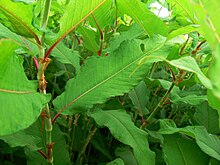Himalayan knotweed
| Persicaria wallichii | |
|---|---|
 |
|
| Scientific classification | |
| Kingdom: | Plantae |
| (unranked): | Angiosperms |
| (unranked): | Eudicots |
| (unranked): | Core eudicots |
| Order: | Caryophyllales |
| Family: | Polygonaceae |
| Genus: | Persicaria |
| Species: | P. wallichii |
| Binomial name | |
|
Persicaria wallichii Greuter & Burdet 1989 not Polygonum wallichii Meisn. 1826 |
|
| Synonyms | |
|
Synonymy
|
|
Persicaria wallichii is a species of flowering plant in the knotweed family known by the common names Himalayan knotweed and cultivated knotweed.
Persicaria wallichii is native to Asia (southwestern China, Indian Subcontinent, Myanmar, Afghanistan) and it is planted many places as an ornamental. It has the capacity to become an invasive species and has established itself in some parts of North America, primarily the Pacific Coast of the United States and Canada. It is an invasive weed in the mountains of Sri Lanka.
Persicaria wallichii is a rhizomatous perennial herb producing thick, hollow, erect stems easily exceeding one meter (40 inches) in length. Via its rhizomes it can form dense colonies. It may also spread asexually if sections of the stem containing rooting nodes are separated and moved to a new area; chopping the plant into small pieces does not necessarily keep it from growing. The hairy leaves are up to 20 centimeters (8 inches) long. The branching inflorescence is an array of lacy clusters of many small white flowers.
...
Wikipedia
